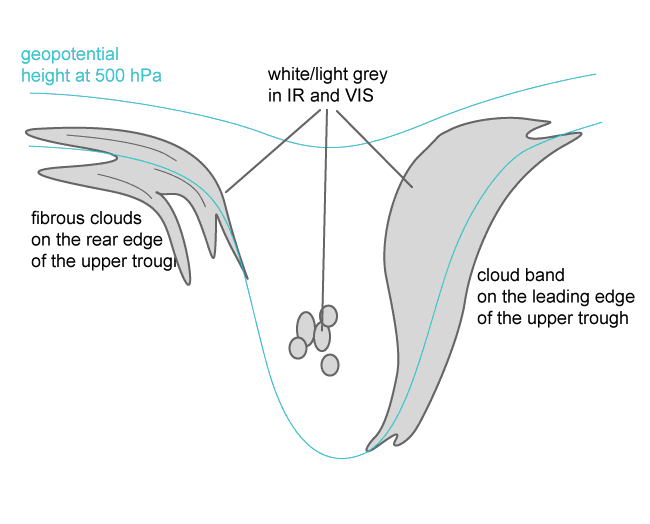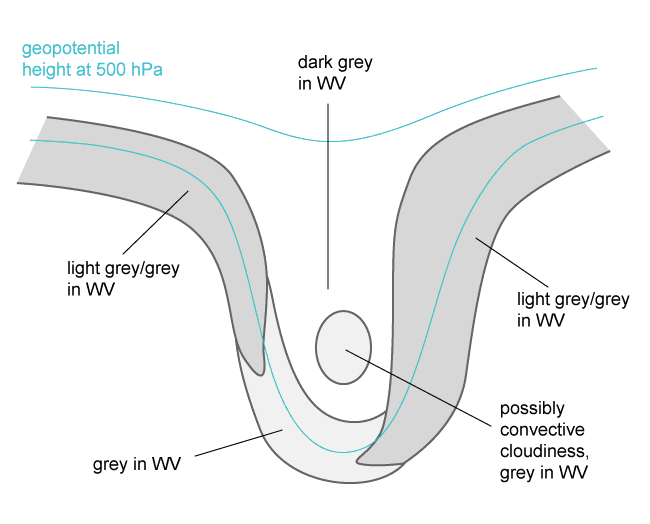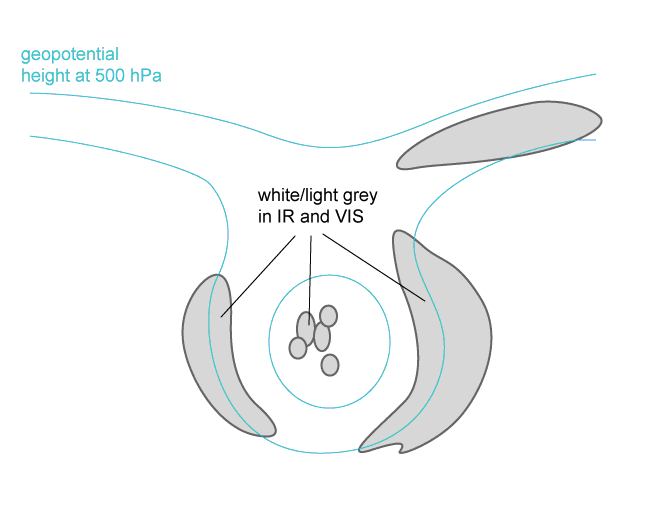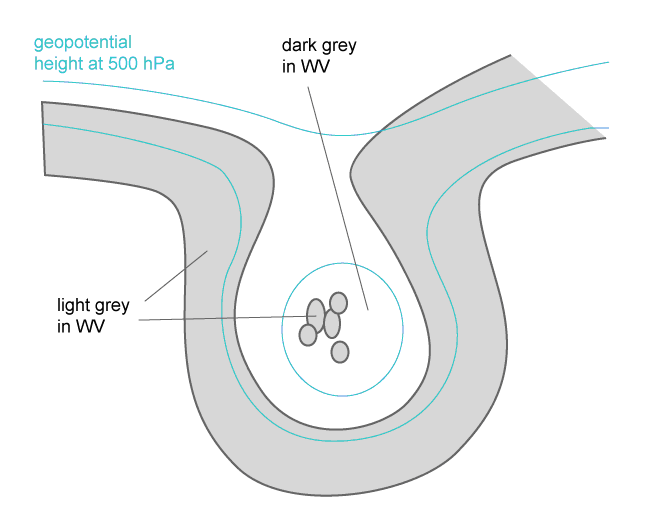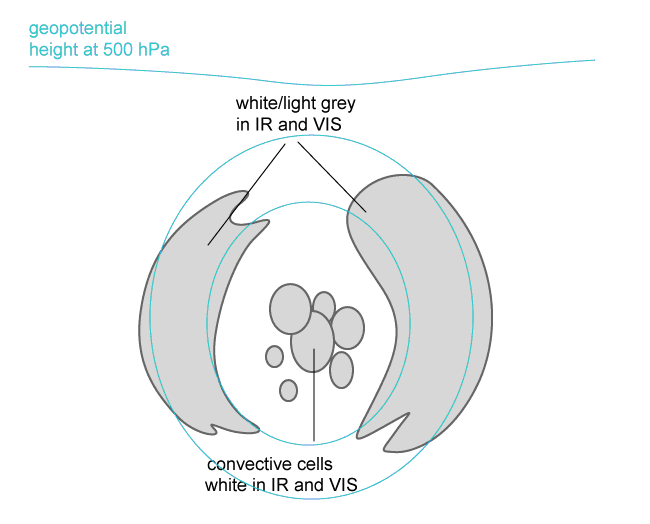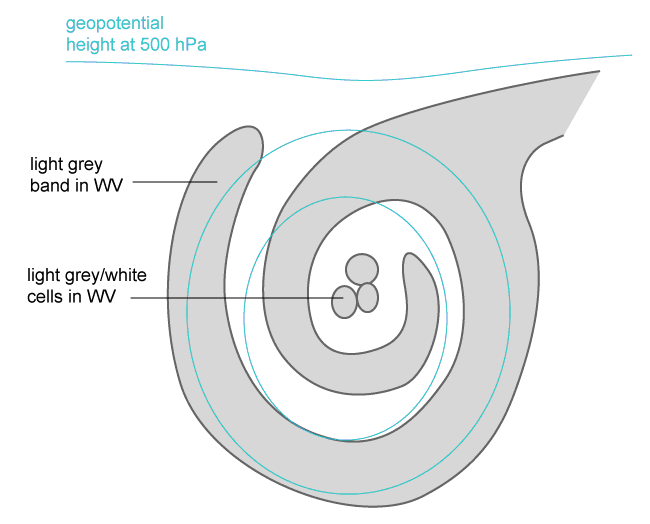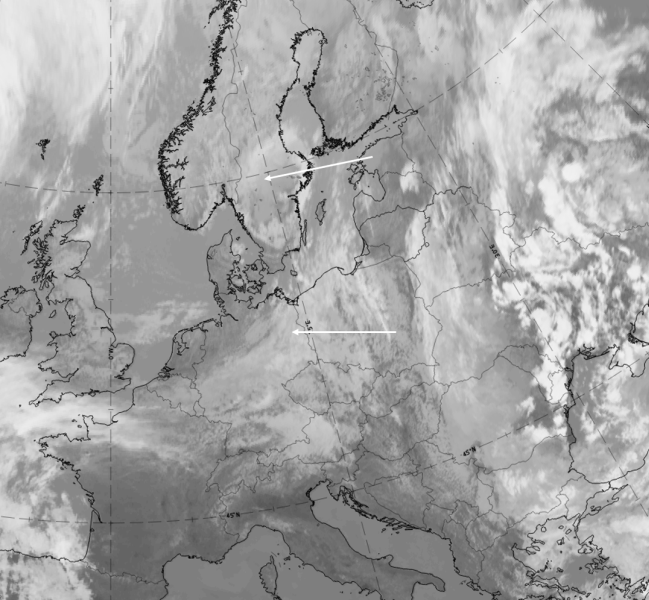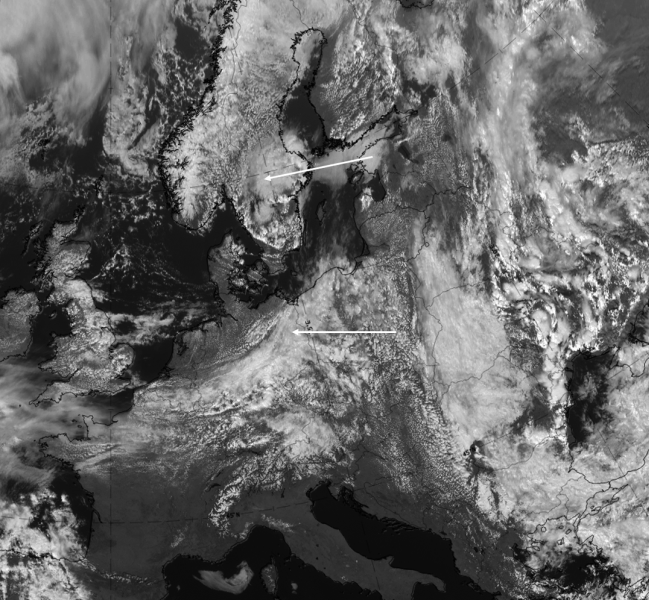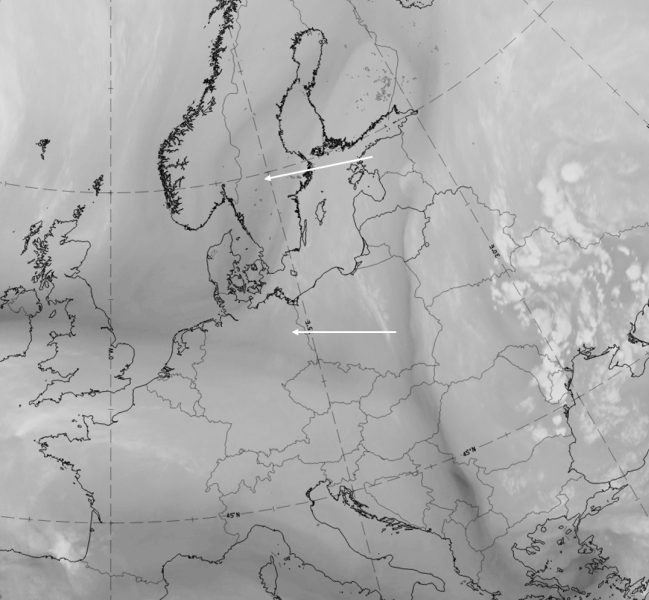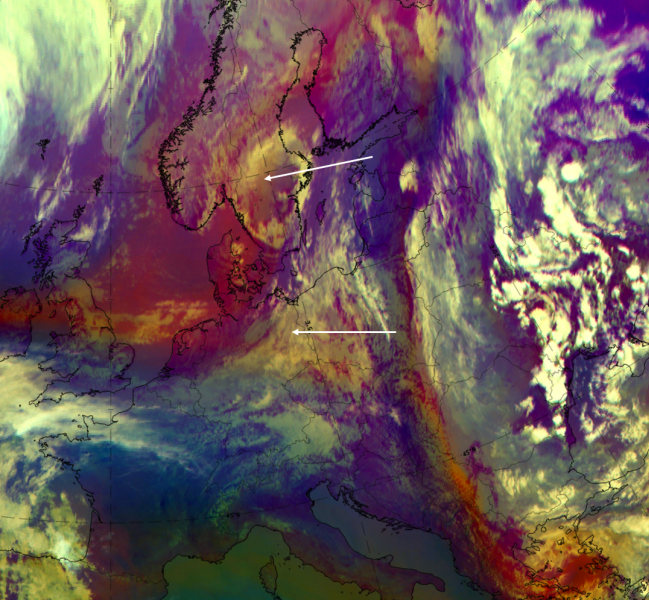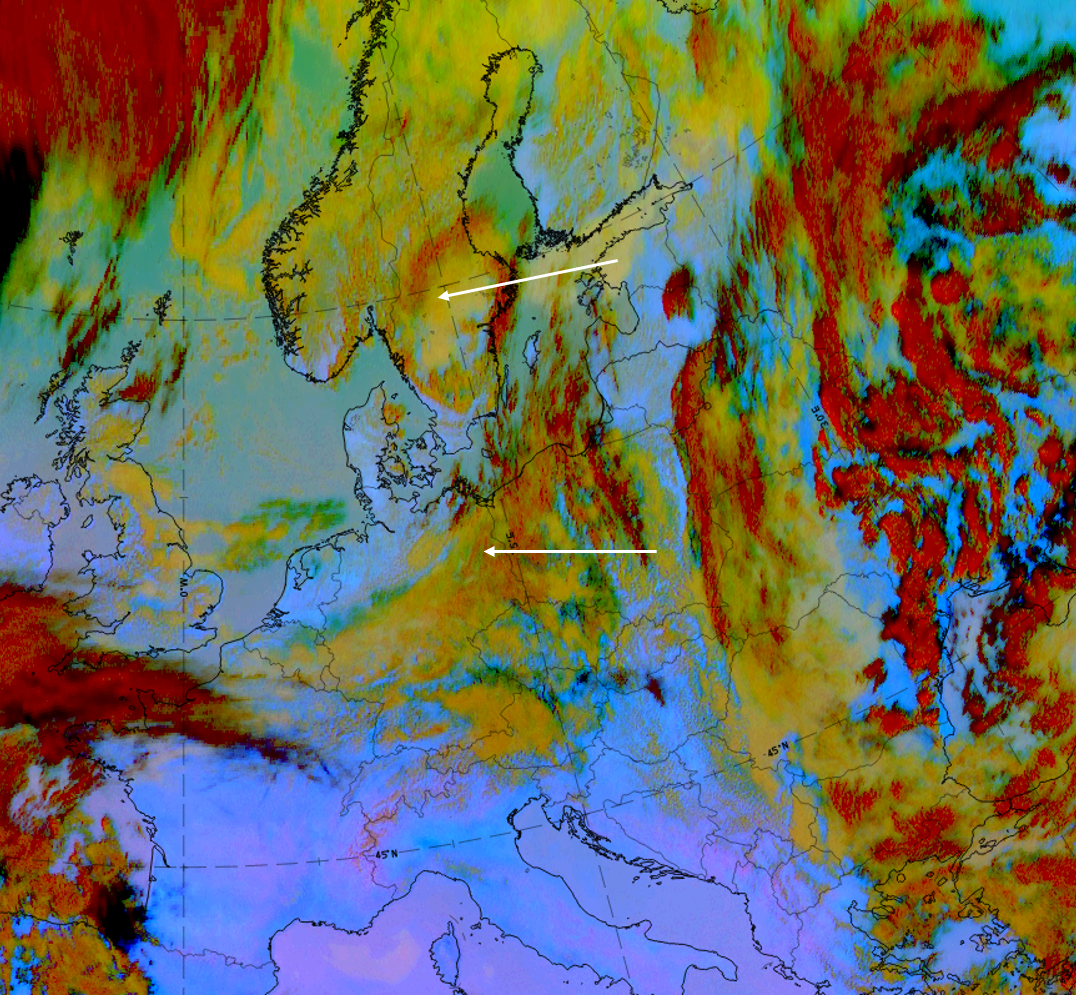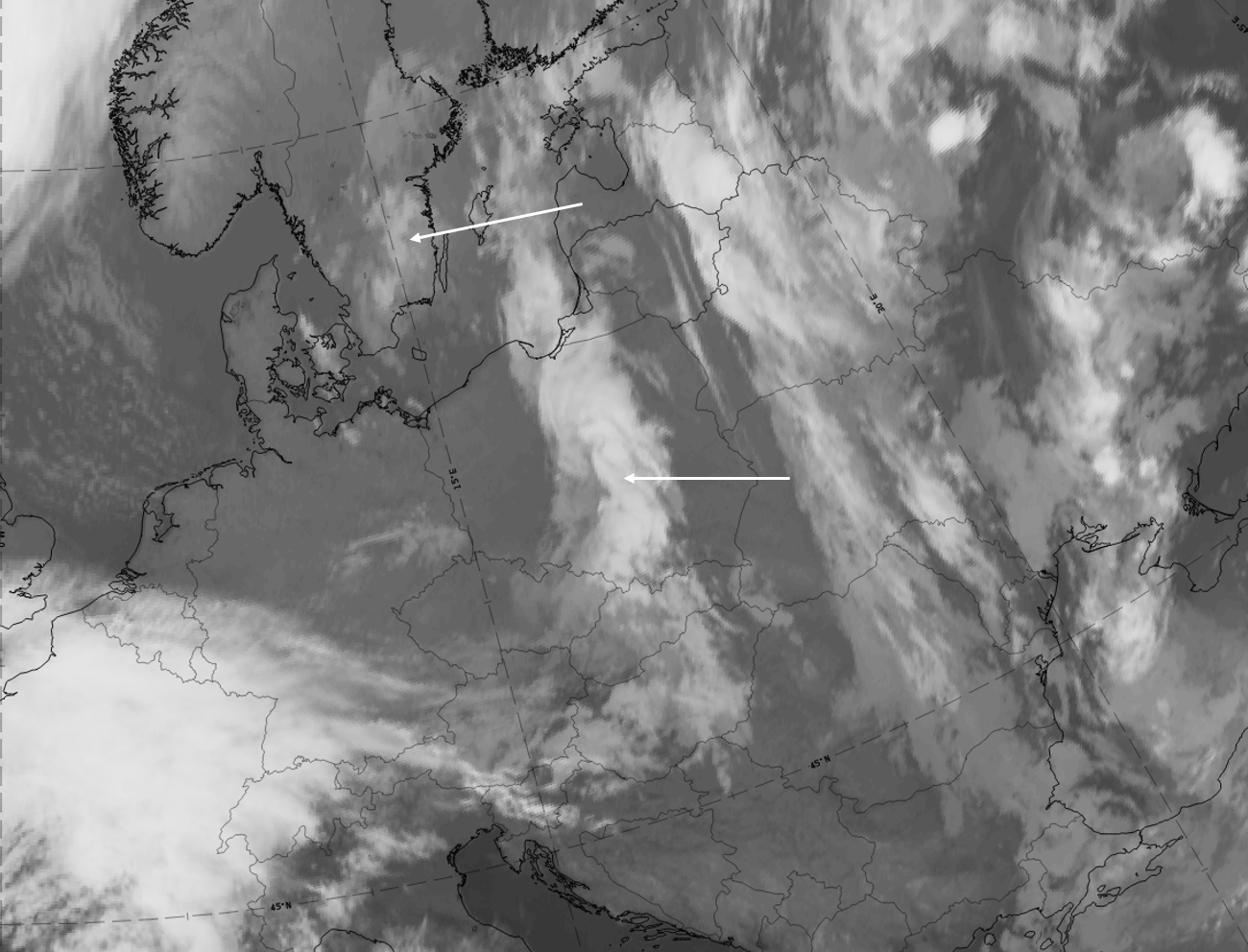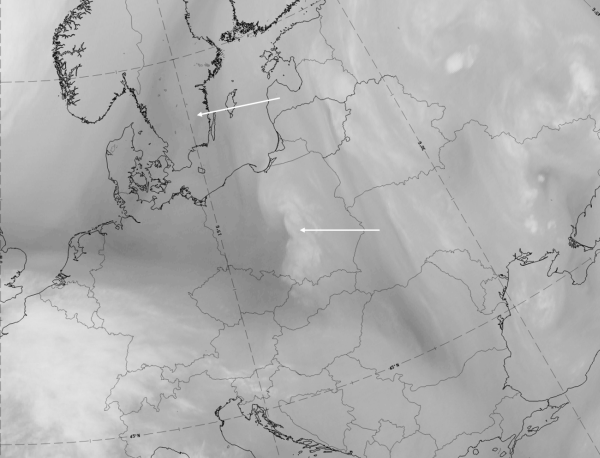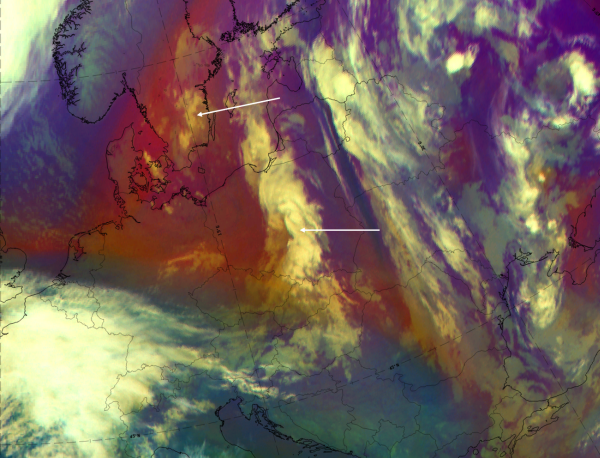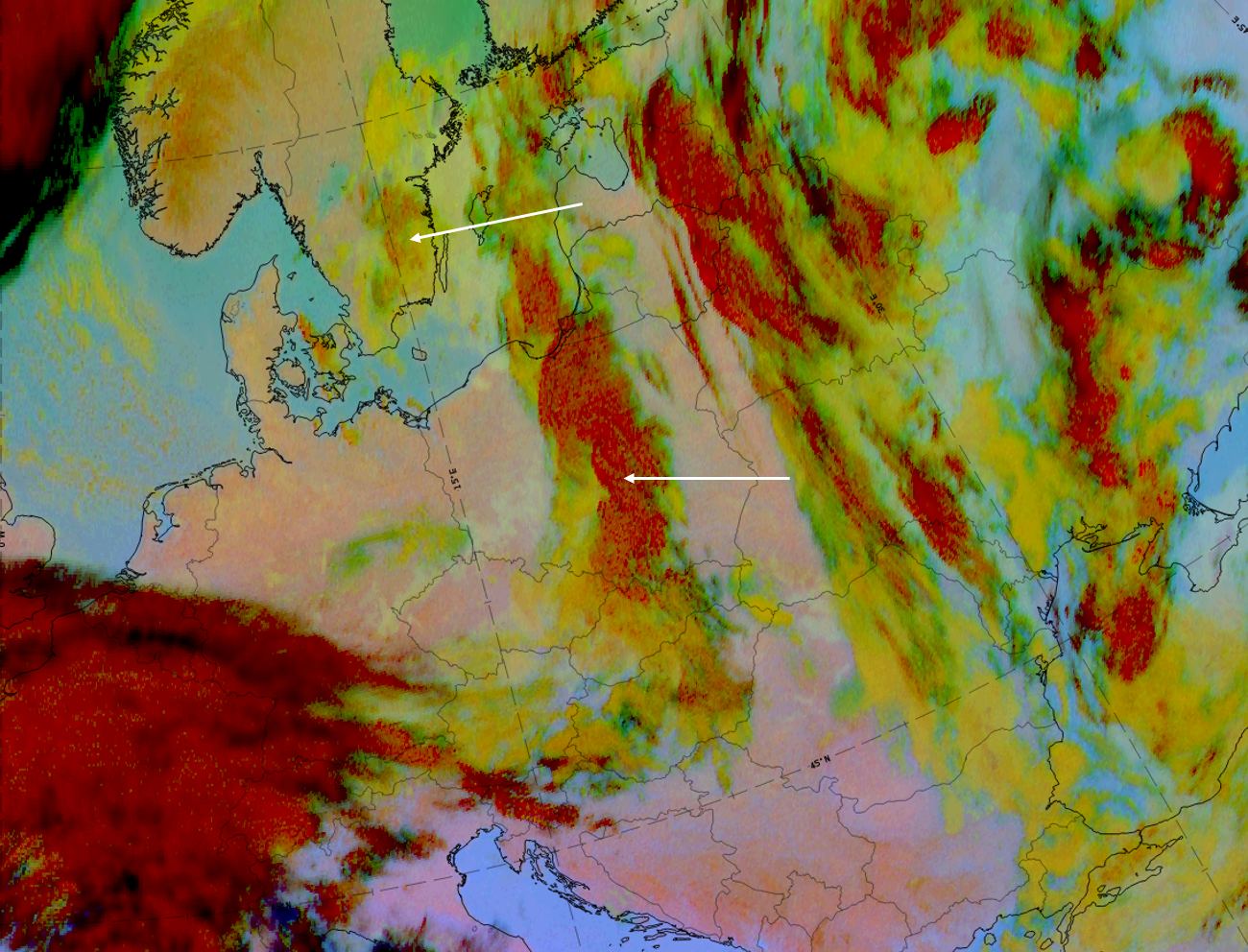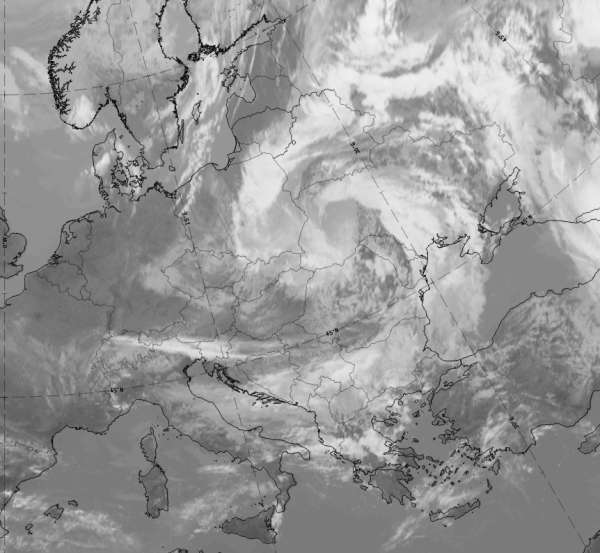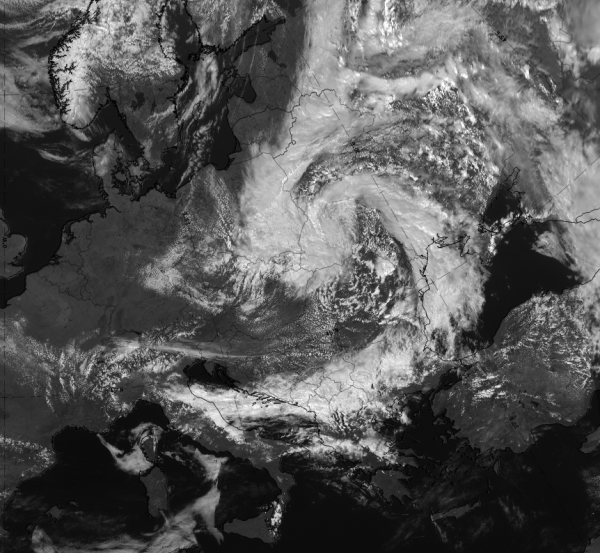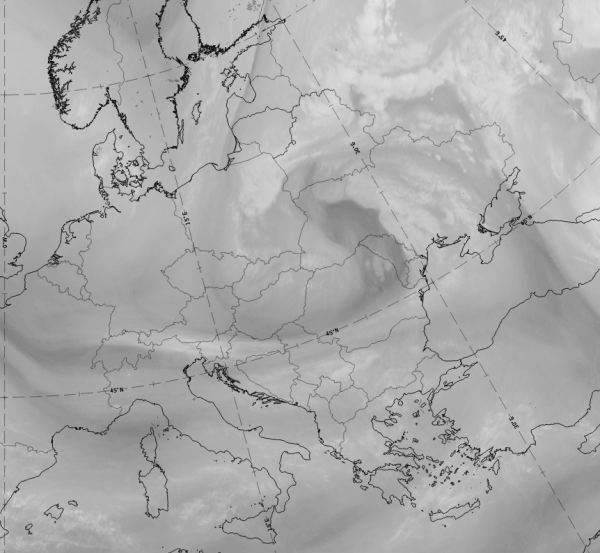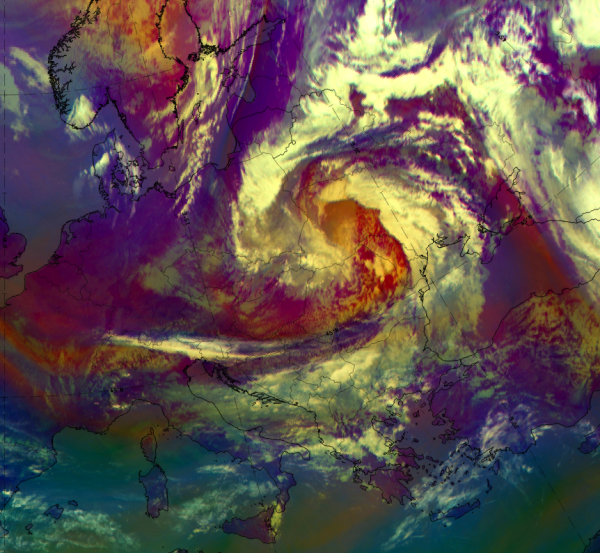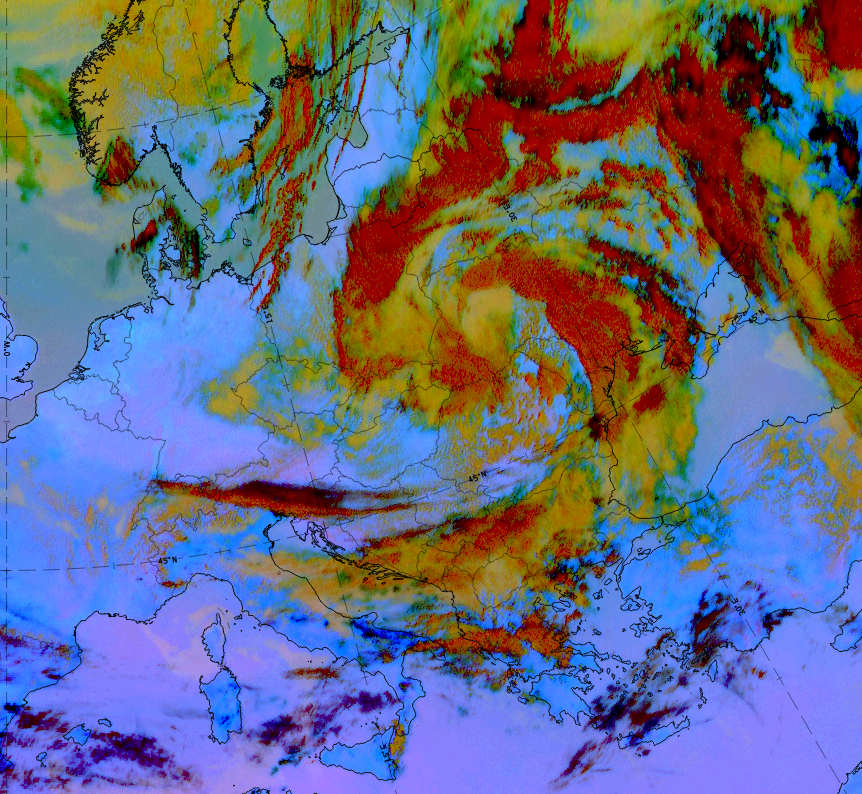Cloud Structure In Satellite Images
Upper Level Lows are relatively long-lived (mostly from 2 to 10 days) phenomena. Their life cycle consists of three stages:
- Upper level trough
- Tear-off
- Cut-off
- Final stage
1. Upper level trough stage
There is a pronounced upper level trough behind a frontal zone.
Appearance in the basic channels:
- In IR10.8 images, a white or light grey cloud band is connected to the frontal zone on the leading side of the trough, while some thin white cloud stripes due to Cloud Fibres exist on the rearward side. There may possiblybe some convective white cells around the axis of the trough.
- In VIS0.6 images, a white or light grey cloud band is connected to the front on the leading side of the trough. Some convective white cells may exist around the axis of the trough.
- In WV6.2 images, light grey bands occur on the leading and rear part of the trough.
Appearance in the basic RGBs:
Airmass RGB:
The most important phenomenon here is the dark brown colour within the trough, indicating the cold and dry air there. Cloud bands and fibres at the boundaries of the trough, as well as possible cloud cells within the trough centre, are very similar to IR.
Dust RGB
The cloud free areas within the trough show blue to pinkish blue colours, while the cloud band at the leading side of the trough usually exhibits dark red colours, indicating thick ice cloud. If clouds exist at the rearward side, it can vary from dark red to black depending on the thickness of the ice clouds there. If there is already cold air cloudiness in the trough centre, this stage of the cut off process usually results in ochre cloud colours, indicating that the cloud-tops are low to mid-level. For cases over land in wintertime, this centre can also be filled by ochre mid-level cloud patches.
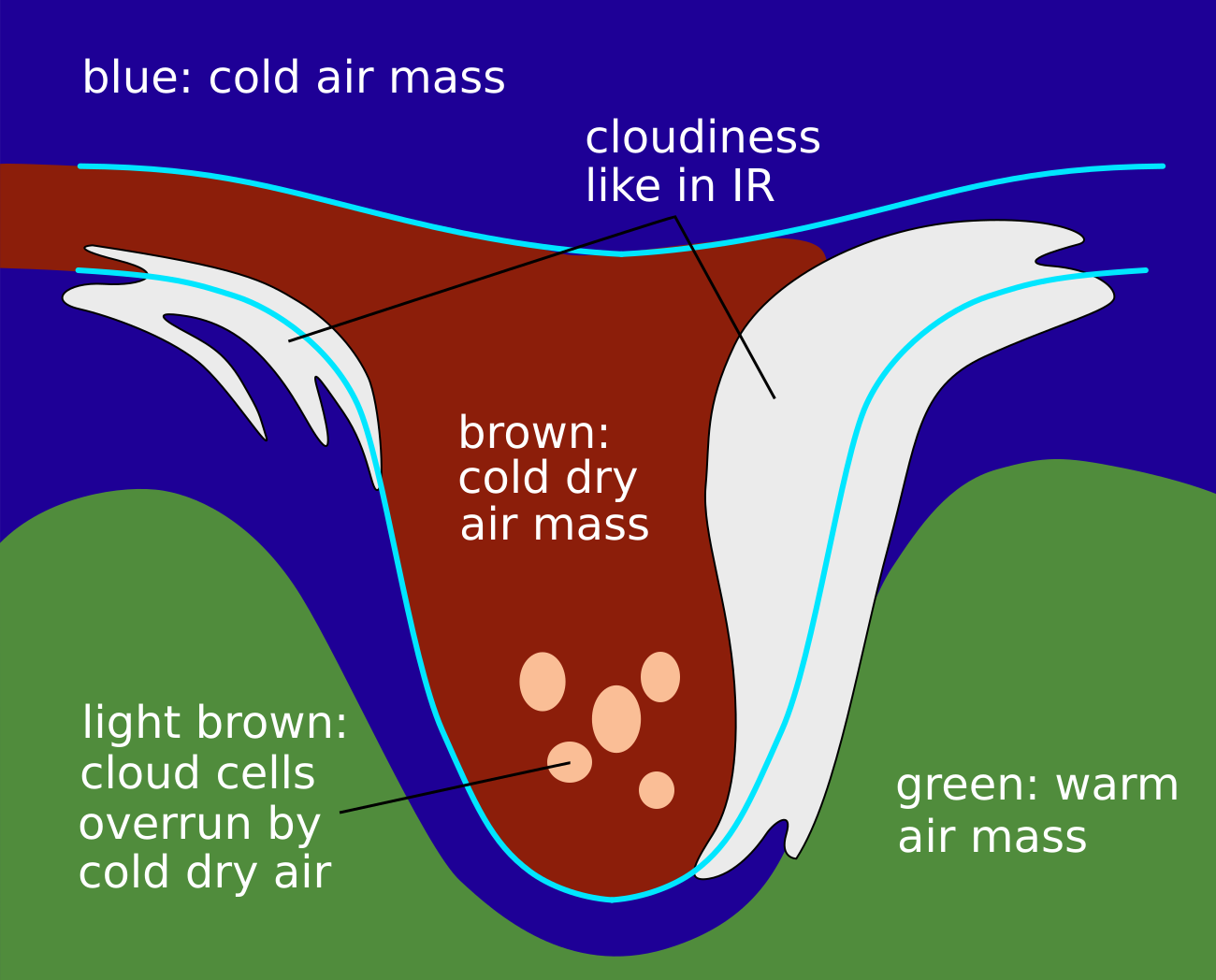 |
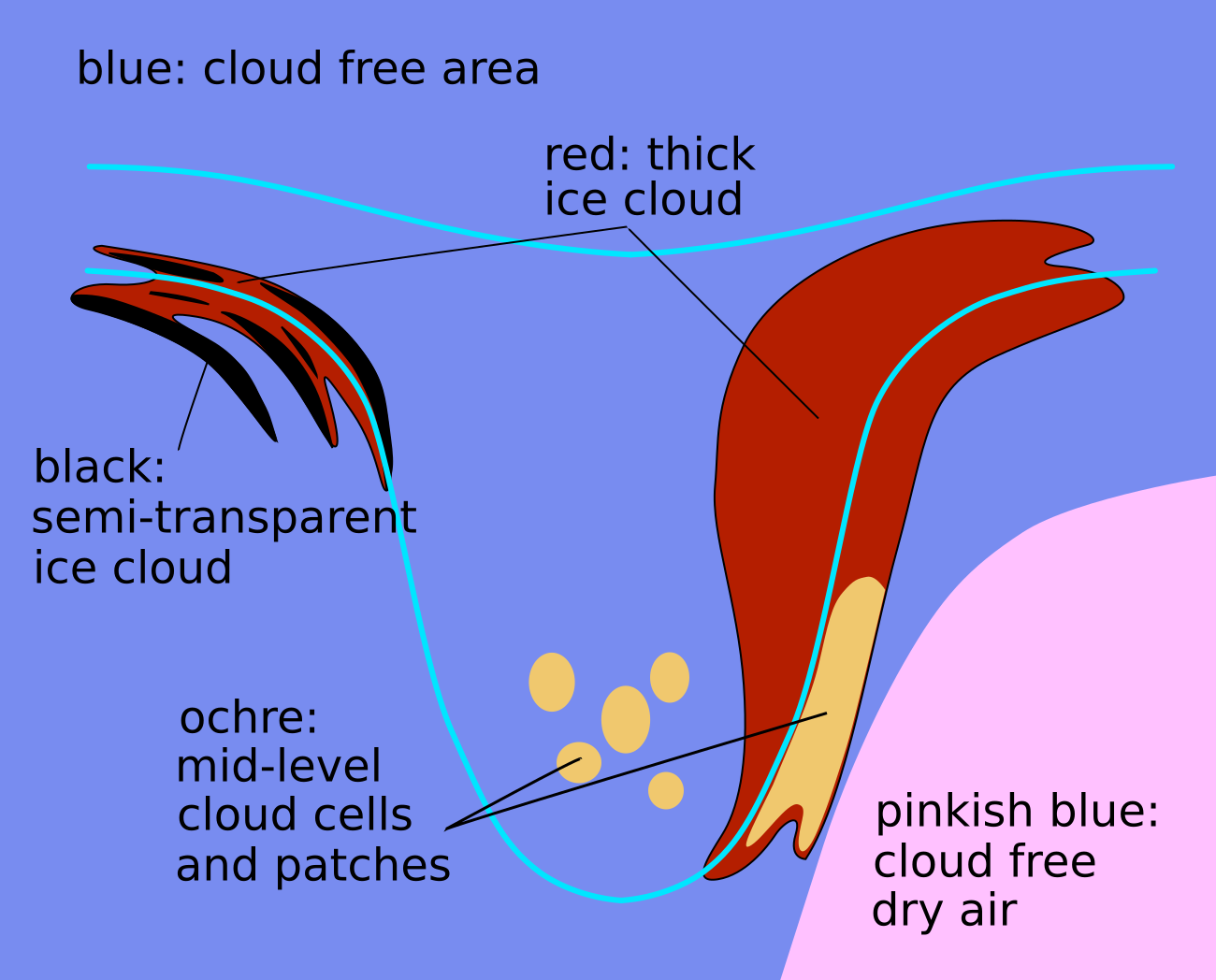 |
Legend: Cut off process: trough stage, Left: air mass RGB; right: dust RGB.
2. Tear-off
The bottom of the upper trough is detached from the main stream resulting in a closed circulation.
Appearance in the basic channels:
- In IR10.8 images, a white to light grey cyclonically curved cloud band is on the leading side of the trough - possibly also on the rear side. Some white convective cells may occur between the bands.
- In VIS0.6 images, a grey cyclonically curved cloud band exists on the leading side of the trough, possibly also on the rear side. Some white convective shells may occur between the bands.
- In WV6.2 images, a grey cyclonically curved cloud band exists around the detaching low.
Appearance in the basic RGBs:
Airmass RGB
At this stage of the cut-off process, air mass composition makeup is the same as the trough stage before: dark brown colours in the centre are concentrated in the circle-like centre and cold air cloud (if it exists) is mostly overrun by this dry air, which results in a more ochre colour. Existing cloud bands at the boundaries are similar to those in the IR channel. Often the cloud band at the rear of the former trough is only weakly developed, or is not present at all.
Dust RGB
The same as before the cloud boundaries vary between ochre and dark red; the same is true for the clouds in the centre which often start to increase in thickness.
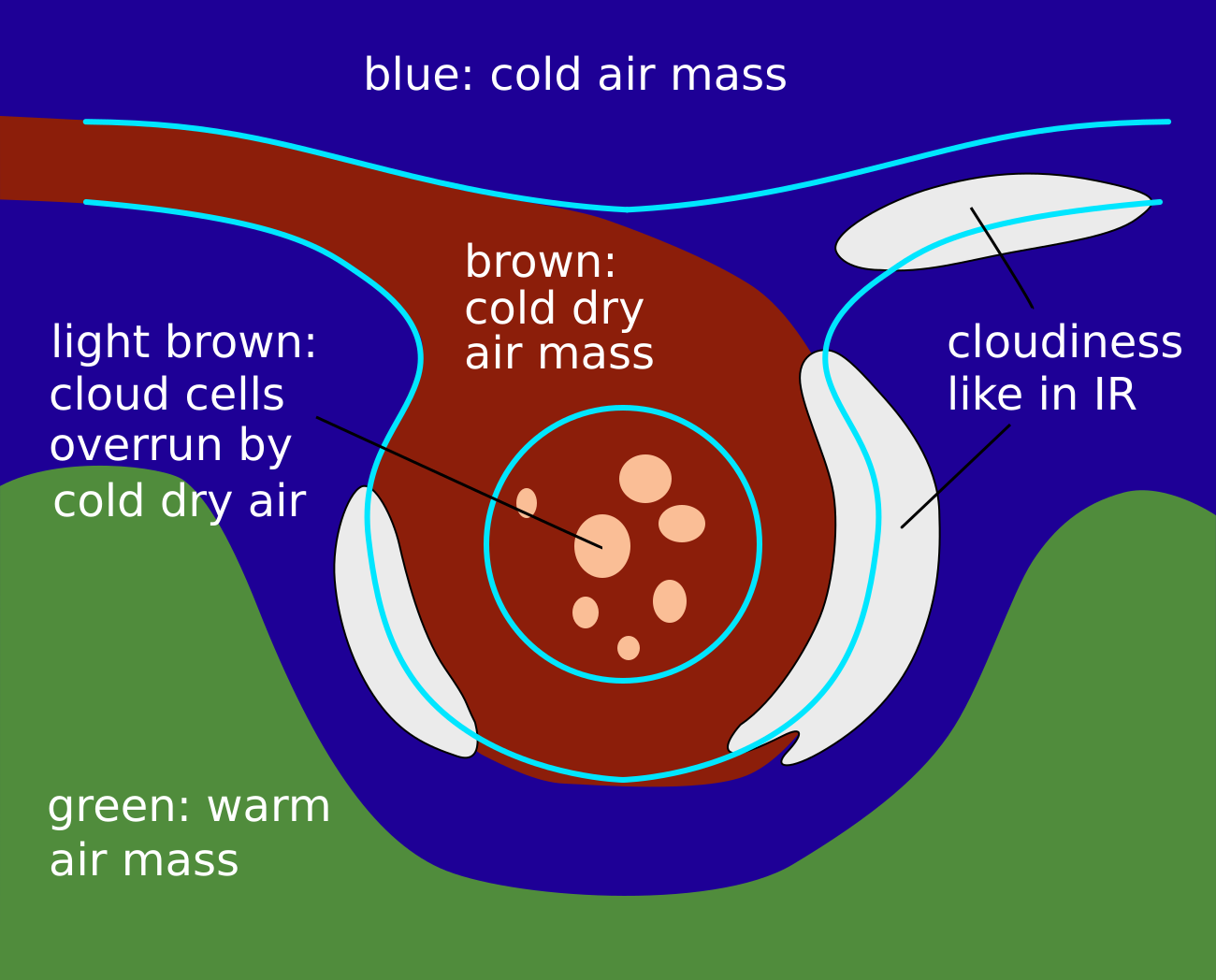 |
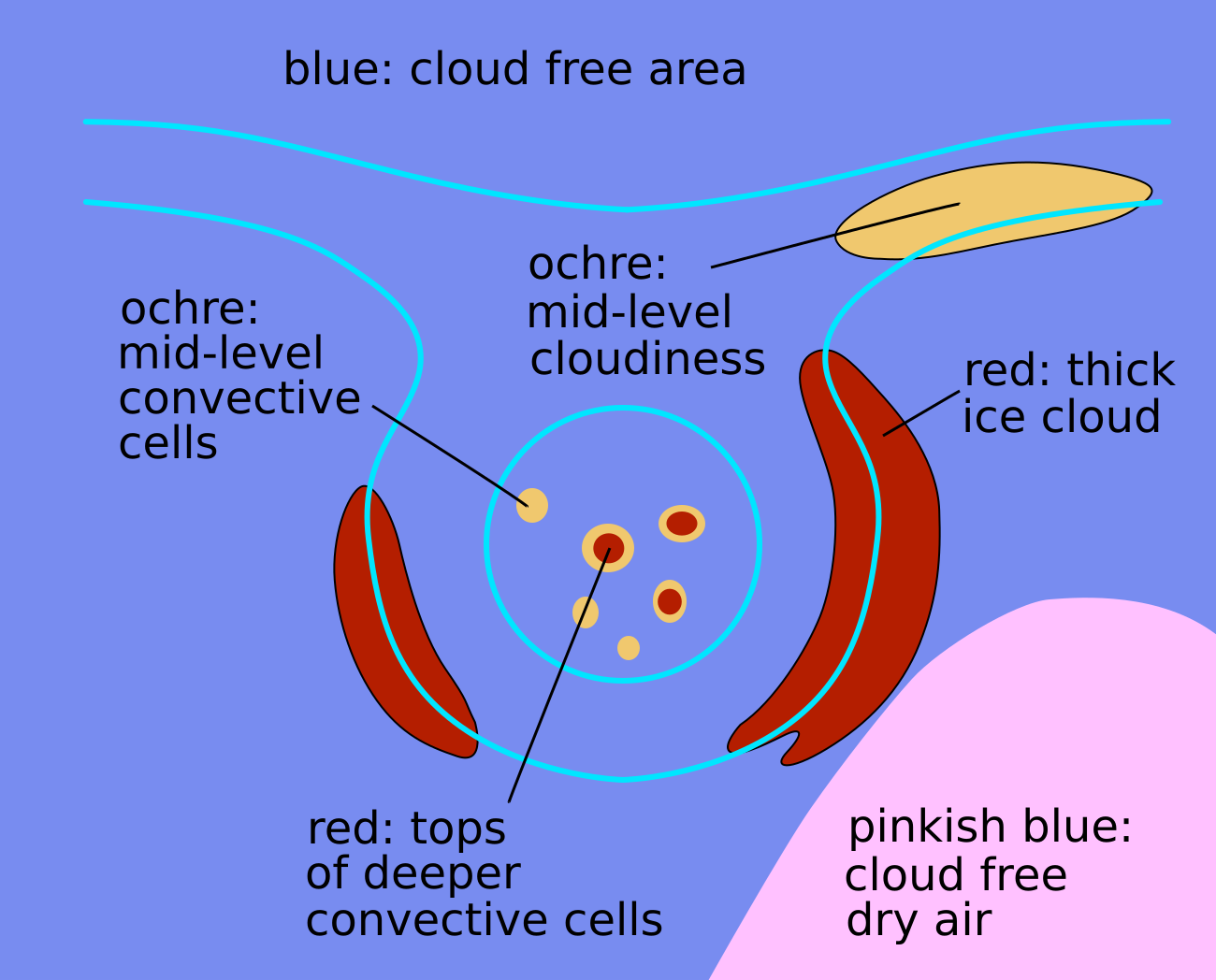 |
Legend: Cut off process: tear-off stage, Left: air mass RGB; right: dust RGB.
3. Cut-off stage
The Upper Level Low is separated from the main upper stream.
Appearance in the basic channels:
- In IR10.8 and VIS0.6 images, white to light grey cyclonically curved cloud bands exist on the leading and rearward side of the low, later forming a spiral. Some white convestive cells may exist within it.
- In WV6.2 images, a round area or a spiral of grey clouds exist, with some white cells on the leading side.
Appearance in the basic RGBs:
Airmass RGB:
In the cut-off stage the airmass RGB is a further development of the stage before. The most pronounced feature is the dark brown colour in the cold and dry centre.
Dust RGB
The most pronounced features are the dark red, thick ice cloud in the cloud band, which are spiralling around the cut off low centre. Cold clouds in this centre are now thick, demonstrated by the dark red colour for thick ice cloud.
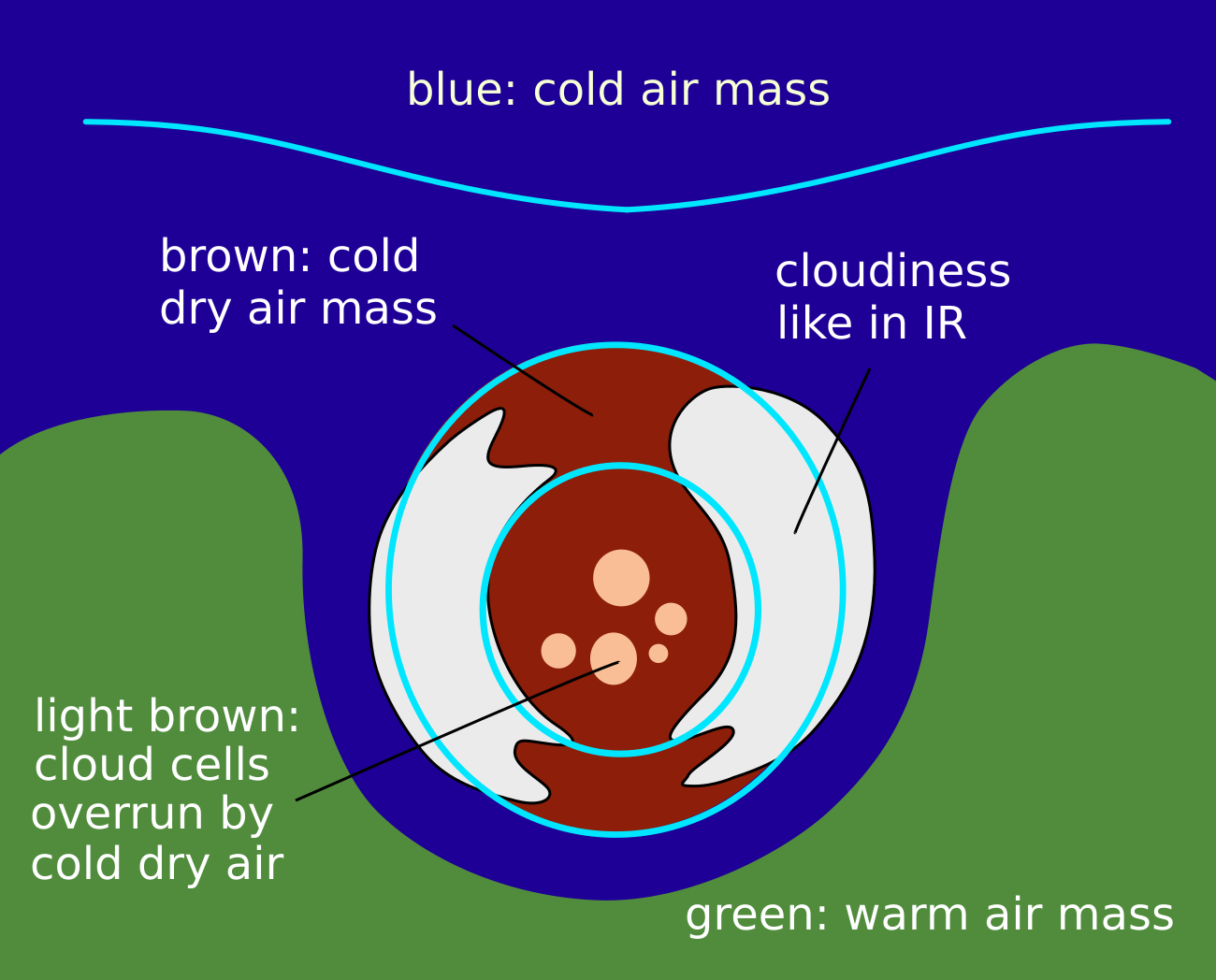 |
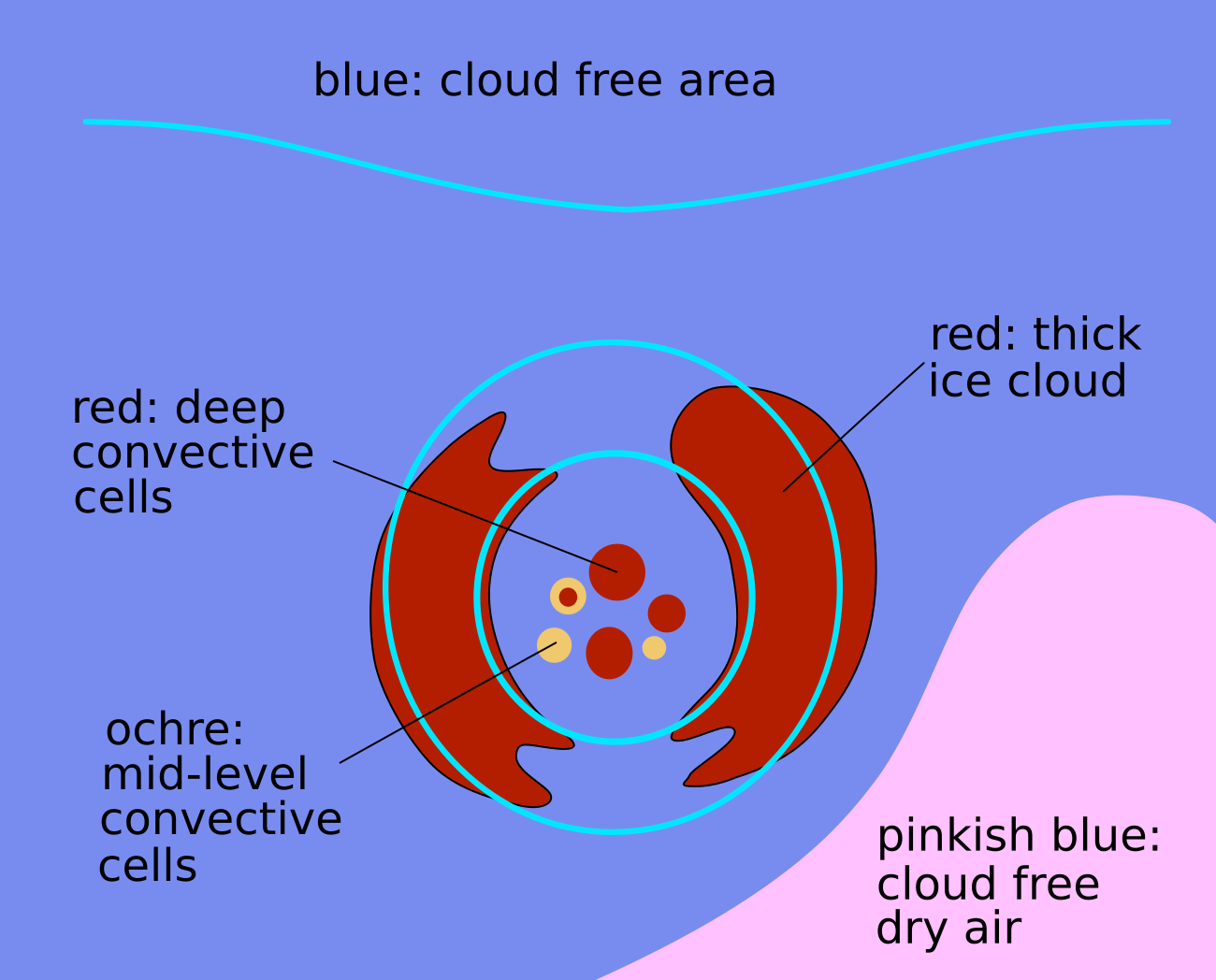 |
Legend: Cut off process: cut-off stage, Left: air mass RGB; right: dust RGB.
4. Final stage
The Upper Level Low merges with the main stream, or dissolves slowly while being almost stationary.
Appearance in the basic channels:
- In IR10.8 and VIS0.6 images there are light grey cyclonically curved stripes that merge with the white cloud band of a frontal zone.
- In WV6.2 images there is a dark grey area that soon disappears under the light grey area of the frontal zone.
Cut-off processes can last several days. During this long development phase, cloud features can vary a bit from the ideal schematics or show only some features from it. In the two cases shown below, typical areas for cut-off processes over Europe are shown.
In the case of 4 - 7 May 2020 the cut-off process starts with a trough over Scandinavia which moves and develops into Central Europe. The trough and the tear off stage are accompanied by less distinct cloud features than those described for a well-developed case. However, the cut-off and final stage are very distinct.
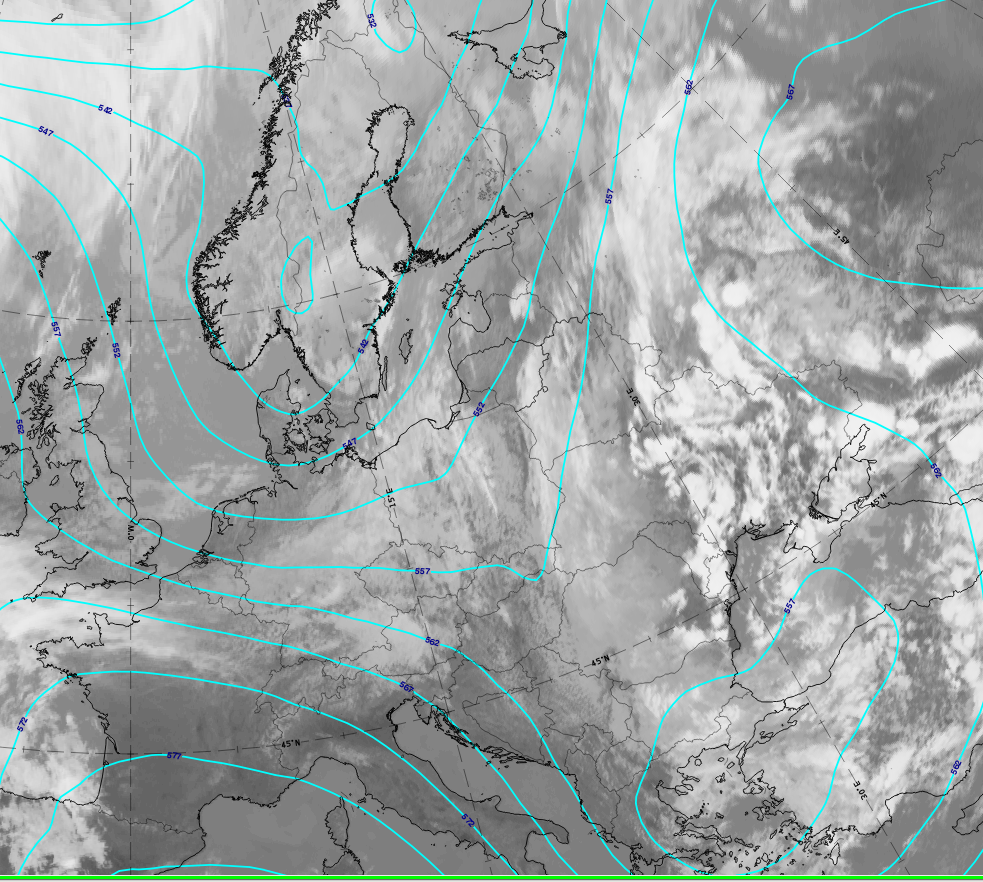 |
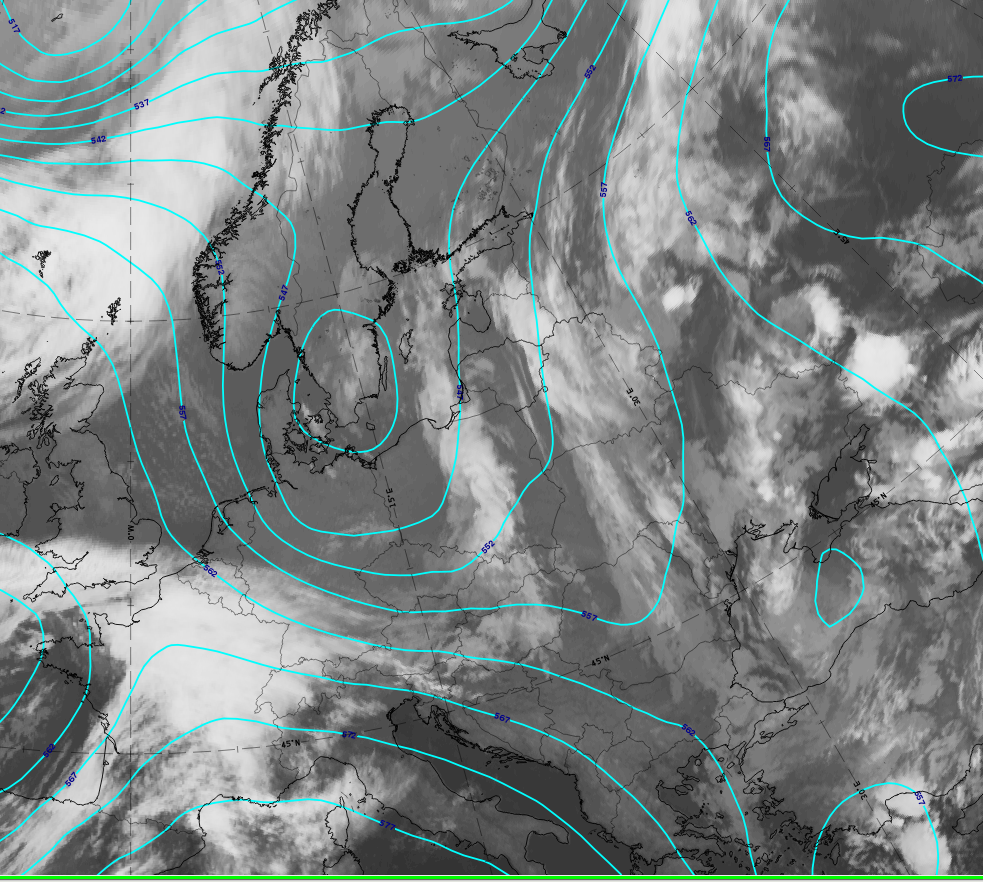 |
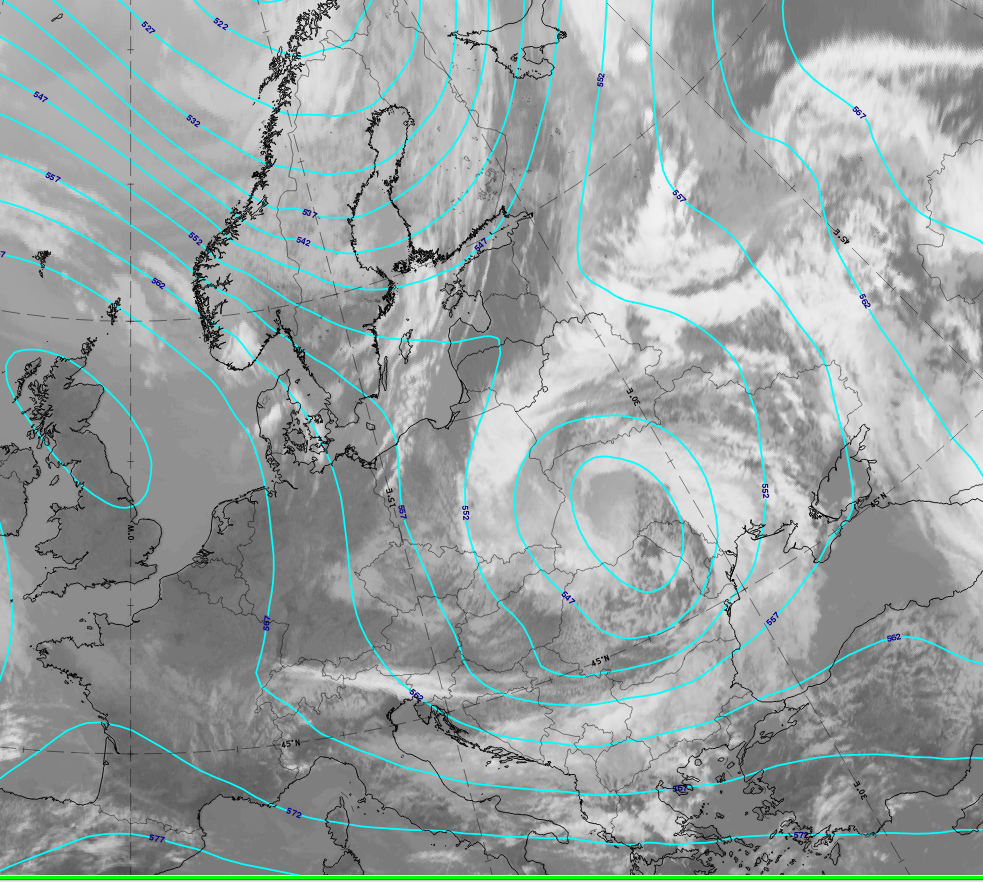 |
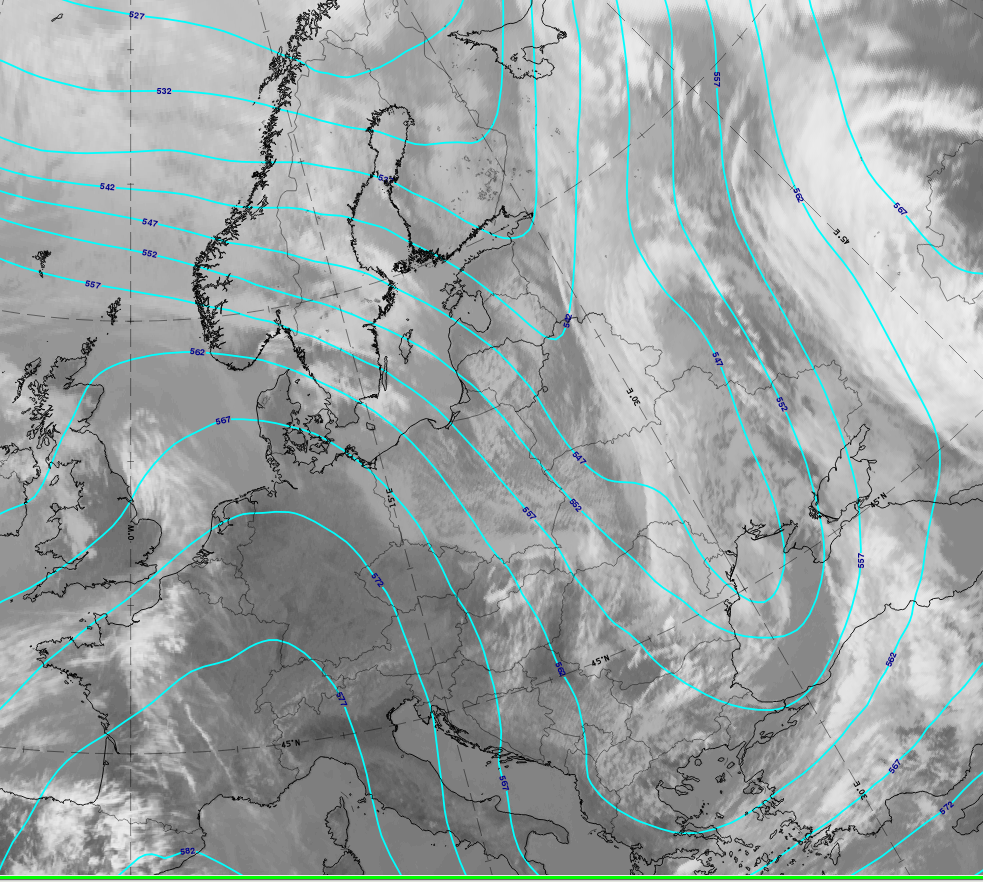 |
4 - 7 May 2020: cut-off process: IR; cyan lines: Height contours 500 hPa.
u.l.: 4 May at 12 UTC trough stage; u.r.: 5 May at 3 UTC tear-off stage; l.l.: 6 May at 12 UTC cut-off stage; l.r.: 7 May at 12 UTC final stage.
*Note: click on the image to access image gallery (navigate using arrows on keyboard)
The second case which is from 12 - 14 May (and continued beyond this), starts with a trough over the Atlantic and during the cut-off process this shifts to the southeast with a very well-developed cut-off stage over Spain. All stages have very pronounced cloud features but a final stage cannot be observed - the cut-off feature lasts for several days longer and thereby moves southward out of the panel frame.
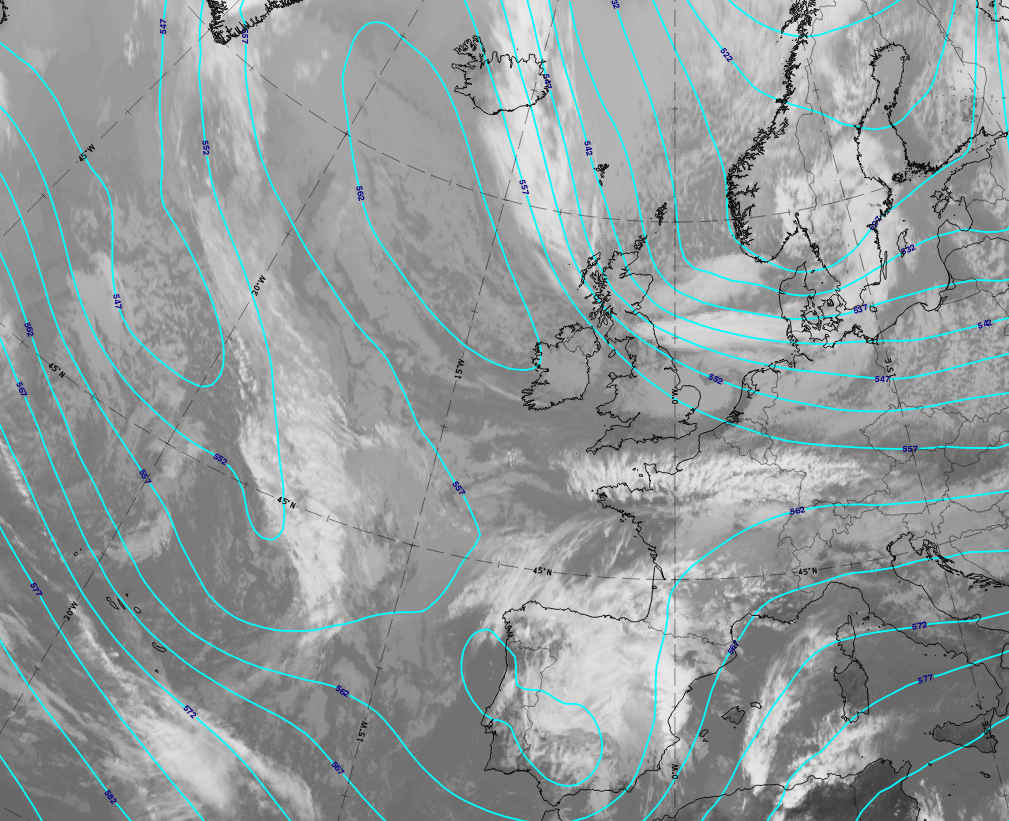 |
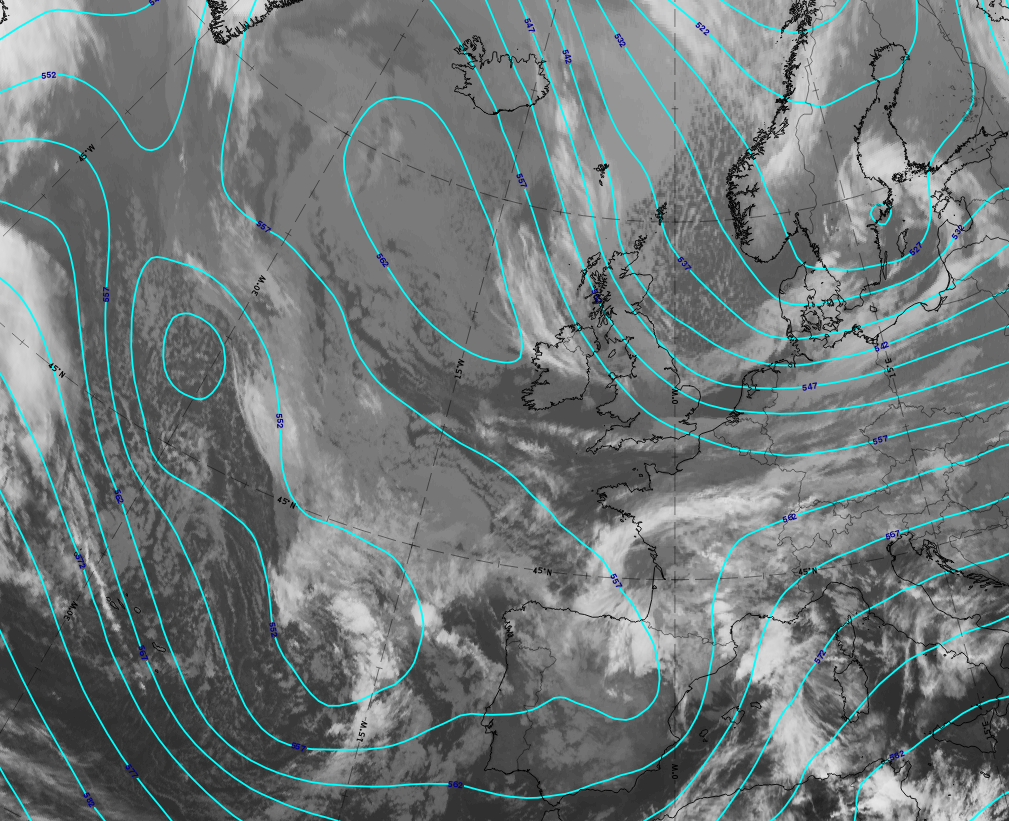 |
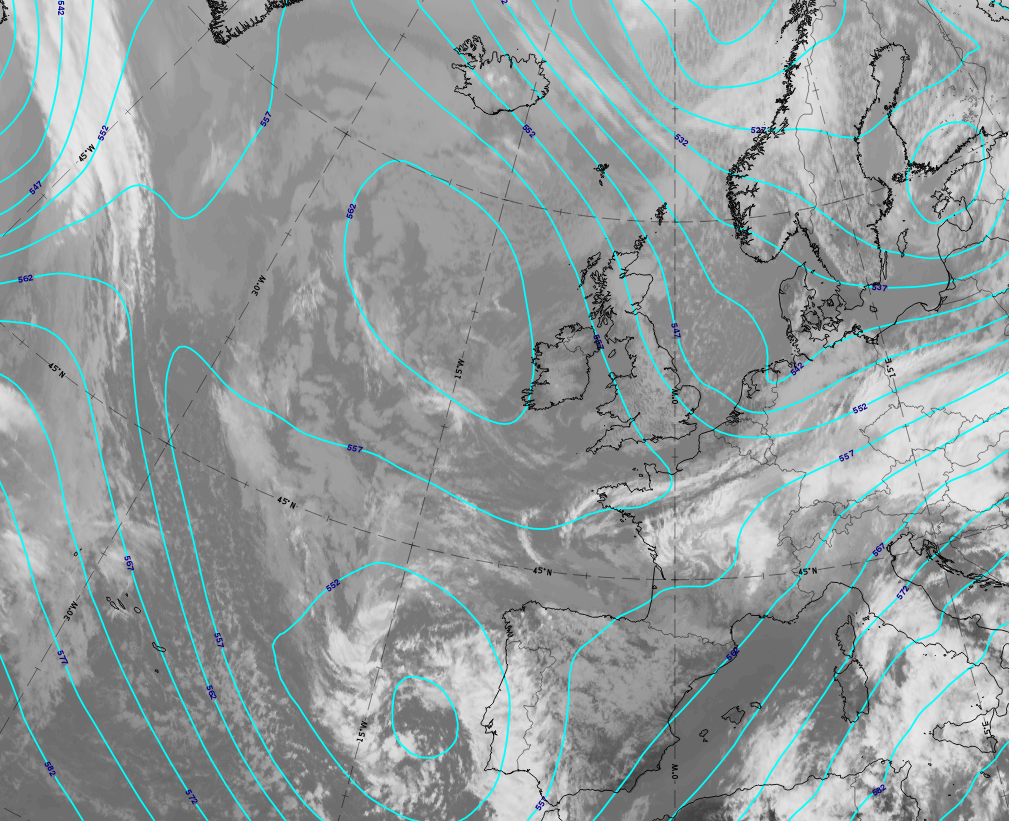 |
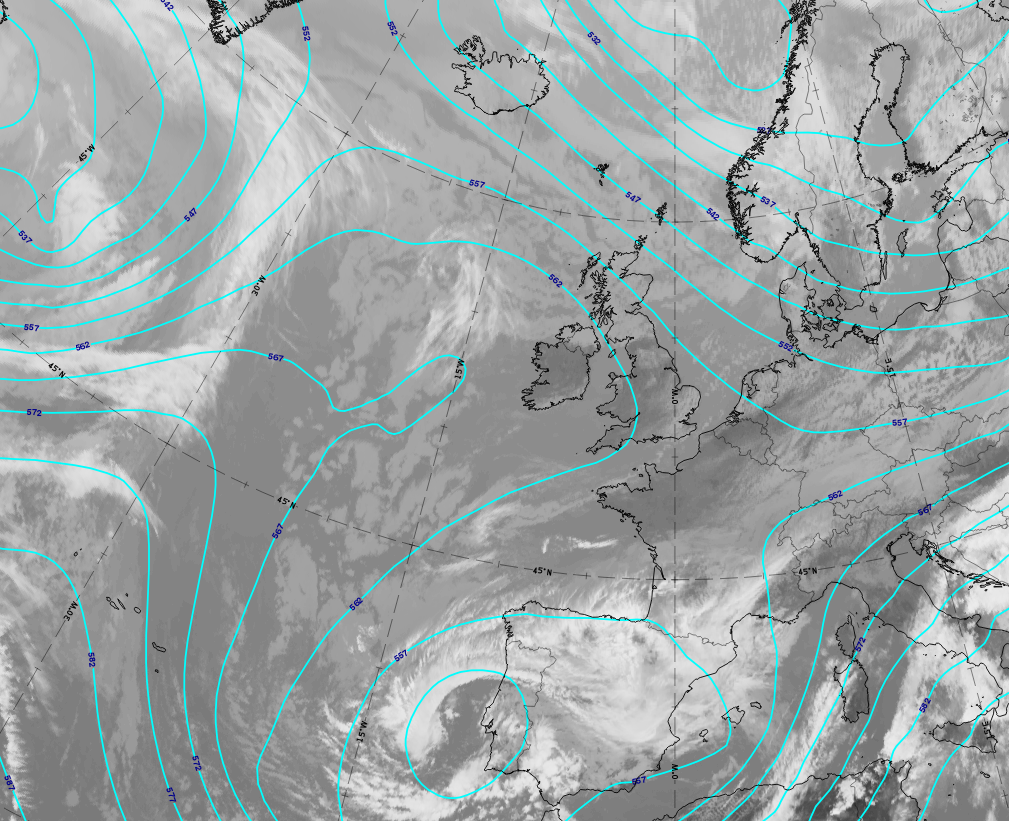 |
12 - 14 May 2020: cut-off process: IR; cyan lines: Height contours 400 hPa.
u.l.: 12 May at 15 UTC trough stage; u.r.: 13 May at 00 UTC tear-off stage; l.l.: 13 May at 15 UTC cut-off stage; l.r.: 14 May at 12 UTC advanced cut-off stage.*Note: click on the image to access image gallery (navigate using arrows on keyboard)
The case of 4 - 7 May 2020 is chosen for demonstrating the basic channels and the basic RGBs for the typical cut-off development stages.
Trough stage: 4 May 2020 at 12 UTC
Frontal cloud band at the southern leading side of the trough over Germany and Poland; some cloud cells and patches in the trough centre over south Sweden; no cloud system at the rear side of the trough.
|
|
|
|
Legend:
4 May 2020 at 12UTC: 1st row: IR (above) + HRV (below); 2nd row: WV (above) + Airmass RGB (below); 3rd row: Dust RGB (black arrows indicate the cloud band at the rear of the trough, as well as cold air cloudiness within the trough) + image gallery.
*Note: click on the Dust RGB image to access image gallery (navigate using arrows on keyboard).
| IR | A light grey to white cloud band exists at the southern leading side of the upper level trough. Some light grey clouds exist in the trough centre over Southern Sweden. No cloud system exists at the rear side of the trough - the next cloud system is far to the NW. |
| HRV | A white cloud band at the leading side of the trough, with white cells in the trough centre over Sweden. |
| WV | The whole area shows grey colours but not distinct band-like structures; darker grey colours exist in the trough centre over Sweden. |
| Airmass RGB | Dark brown colours in the trough centre representing the cold and dry air; clouds at the leading side are overrun by cold air (blue colours) in the south and cold and dry air (brown colours) to the north. |
| Dust RGB | A cloud band at the leading side is mostly ochre in colour, representing mid-level cloud. Some fibres also exist. |
Tear-off stage: 5 May 2020 at 03 UTC
The cloud band at the leading edge of the torn-off low can be seen over Poland. Some cloud cells exist in the low centre over Southern Sweden and some fibrous clouds from the next system exist over Northern Norway.
|
|
5 May 2020 at 03UTC: 1st row: IR; 2nd row: WV (above) + Airmass RGB (below); 3rd row: Dust RGB + image gallery.
*Note: click on the Dust RGB image to access image gallery (navigate using arrows on keyboard).
| IR | All three cloud systems accompanying the leading side, the centre and the rearward side of the tear-off low, are white. |
| HRV | Not available at this point of time. |
| WV | Light grey colours on the cloudy areas, especially at the leading side; dark grey shades exist in the centre of the torn-off low; cyclonic rotation becomes visible. |
| Airmass RGB | Dark brown colours partly in the tear-off low centre and above the cold air cloud; very bright cloud band at the leading side. |
| Dust RGB | Dark red colours are the cloud band at the leading side of the tear-off low, indicating thick ice cloud; the same is true for small cold air clouds in the centre over Southern Sweden; the cloud free areas are mostly in pinkish blue, indicating higher humidity in the air near the ground below. Some greenish areas indicate thin mid-level cloud. |
Cut-off stage: 6 May 2020 at 12 UTC
Two cloud bands spiral around the cut off low centre: the southern one developed from the frontal band at the rear side of the trough and the northern one developed within the cyclonic rotation, after cut off from cloudiness in the northeast. Some small cold air cells exist in the cut off low centre.
|
|
|
|
6 May 2020 at 12UTC: 1st row: IR (above) + HRV (below); 2nd row: WV (above) + Airmass RGB (below); 3rd row: Dust RGB + image gallery.
*Note: click on the Dust RGB image to access image gallery (navigate using arrows on keyboard)
| IR | Two cloud bands are cyclonically curved around the cut of low centre, with light grey to white grey shades; white small cells in the centre indicated by some light grey cloud patches. |
| HRV | A white cloud band around - and white cloud cells within - the cut-off low centre; white low to mid-level cloud patches in the centre are very distinct in the HRV channels. |
| WV | Cloud bands are white to light grey; the centre of the cut off low is dark grey. |
| Airmass RGB | Bright cloud bands with similar appearance to those in the IR channel; blue colours accompanying the bands indicate the cold air. The cut-off low centre has dark brown colours indicating the cold and dry air there. |
| Dust RGB | The two curved cloud bands are dark red over a large area, representing the thick ice cloud; the ochre colours indicate the mid-level water clouds which are partly in the cloud bands and partly in the cut off low centre. |
The air below an Upper Level Low is potentially unstable, which leads to the so-called core convection and convective cloudiness. Over warm sea this convective development can be intensive. Contrary to this, the centre of an Upper Level Low over land is often overcast with low or middle level cloudiness with some convective cells embedded.
Other conceptual models that may look like an Upper Level Low in satellite images are Comma (see Comma) and Polar Low (see Polar Low). These can be separated from each other with the help of numerical fields, especially on the 500 hPa level.
